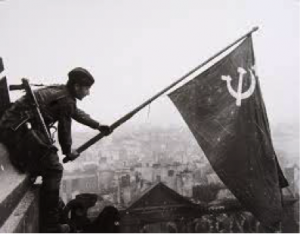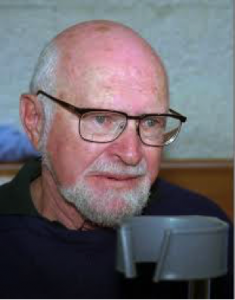Lalkar pays tribute to two staunch communists, heroes of the USSR and of working people everywhere .
Nikolay Belyaev
 Nikolay Belyaev, the last survivor of the group of Red Army heroes who raised the red hammer and sickle flag of the USSR above the Reichstag,
tearing down the swastika, signifying the victory over Nazism on May Day 1945, died peacefully on 8 December 2015 in St Petersburg (formerly
Leningrad) aged 93.
Nikolay Belyaev, the last survivor of the group of Red Army heroes who raised the red hammer and sickle flag of the USSR above the Reichstag,
tearing down the swastika, signifying the victory over Nazism on May Day 1945, died peacefully on 8 December 2015 in St Petersburg (formerly
Leningrad) aged 93.
During the Great Patriotic War, Lieutenant Belyaev was a Komsomol (Young Communist League) leader of the legendary 756th Regiment, which was entrusted with the taking of the Reichstag.
The storming of the building began in the early hours of 30 April 1945. Comrade Stalin had reportedly ordered that it must be taken by 1 May, so that the news could be broadcast during the May Day parade in Moscow. As the red flag was hoisted on the top of the building, fighting is said to have been still going on in the basement.
His long time friend and writer for the Tass news agency, Valentina Ilyina told the Russian media that Belyaev was leading a very active life until the end, “never ceasing from historical and patriotic work”. A book about his wartime exploits is scheduled to be published next year.
After the war, Belyaev saw service with the Soviet Pacific Fleet and then worked in a factory for 40 years before retiring.
He was born in Kobenёvo village in the Tver region to a peasant family. After eight years schooling, he went to work at the newspaper Leninist Hammer. He was engaged in physical training and combat preparation with the just formed ‘Ready for Labour and Defence’ militia, when word reached them that Molotov had just spoken, announcing that Germany had invaded the Soviet Union and the war had begun.
According to a feature broadcast by Russian NTV television for his 90th birthday on 22 November 2012:
“He says that during the entire war he retreated only one day. He was in the defence of Murmansk in the famous Valley of Death, fought in the battle for Staraya Russa, got to Riga, took Warsaw, and then on to Berlin. He was wounded three times .”
NTV also reported: “A committed Communist, Belyaev has kept his beliefs and ideals, even when everything around is changed.
“Viktor Belyaev, his son, calls him ‘a real Bolshevik, as they used to say. He was a member of the Politburo of Krasnoselsky District Committee and is now involved in the patriotic education of youth’.”
Summing up his 90th birthday, NTV’s Alexey Kobylkov observed:“The capture of the Reichstag has now become a vivid recollection, and the Red Flag factory [where he worked] is long gone. But he still has a lot to do every day: [Communist Party] meetings…, conferences, presentations to the youth, and finally, his own anniversary, clearly not the last.”
Marcus Klingberg
 Marcus Klingberg, the most successful spy for the Soviet Union in Israel, passed away on 30 November 2015 in Paris, aged 97.
Marcus Klingberg, the most successful spy for the Soviet Union in Israel, passed away on 30 November 2015 in Paris, aged 97.
Under conditions of great secrecy, the Israeli Zionists sentenced Comrade Klingberg to the maximum 20 years imprisonment in 1983. For decades, he had passed information to the USSR on the Israeli biological weapon programme. He had worked as deputy head of the Israeli Institute for Biological Research.
His arrest, trial and conviction were kept secret for more than a decade. He was held in solitary confinement under an alias and those who enquired about the disappearance of the famous scientist were told that he had suffered a nervous breakdown and was being treated in a psychiatric hospital “somewhere in Europe”.
Announcing his death, his daughter, Sylvia Klingberg said: “He was a communist who acted out of conviction and gratitude to the Red Army for having allowed him to fight the Nazis who massacred his entire family in Poland.”
Born in Warsaw into an ultra-Orthodox Jewish family, Klingberg fled Poland during the Nazi invasion in 1939 and made his way to the Soviet Union, where he studied medicine.
In 1941, after German troops invaded the Soviet Union, he enlisted in the Soviet Red Army.
He returned to Poland at the end of the war, where he discovered that his parents and brother had died in a concentration camp. He emigrated to Sweden and then to Israel in 1948, where he began his intelligence work for the Soviet Union almost immediately.
He served in the Israeli army’s health services, attaining the rank of lieutenant colonel and specialising in epidemiology. He joined the top-secret biological institute, located in Ness Ziona south of Tel Aviv, in 1957. Although the authorities first suspected him in 1963, he was able to continue his activities for another 20 years, before finally being arrested on the strength of evidence from a traitor. He was interrogated for several days before finally signing a confession. In his memoirs, The Last Spy, he wrote:
“What upset me the most was the shame and the regret. Not for having spied for the Soviet Union, no. My sense of humiliation came from the fact that they broke me.”
In a feature article for the Observer newspaper, ‘Marcus Klingberg: the spy who knew too much’, published on 27 April 2014, journalist Peter Pringle wrote:
“It is reasonable to assume that, at Ness Ziona, Klingberg had access to secrets the Soviets sought. In the 1950s and 1960s, the Soviet Union lagged behind the US, Britain and France in the development of chemical and biological weapons. It is well known that Ness Ziona was one of the leading experimental weapons laboratories in the west. Ness Ziona scientists have published papers over the years revealing research into nerve gases, such as tabun, sarin and VX, and incapacitating agents and psychotropic drugs, such as LSD. Researchers also studied how insects could transmit plague, typhus and rabies – all diseases that became part of the US, and in some cases also the British, arsenals before the US… [supposedly] renounced the production of biological and toxin weapons in 1969. The ban became an international arms-control treaty, the Biological Weapons Convention of 1972, but Israel has never signed it.
“‘I also knew about the [Israeli] cooperation with foreign institutes in the western world – the Netherlands, the United States and the United Kingdom’, wrote Klingberg. ‘They presented themselves as acting only for developing protective measures against chemical and biological warfare. Were they really limited to defence research? Blessed be the believers.’
“Moscow Centre showed its appreciation for such access. In one of his clandestine meetings, Klingberg was awarded the Order of the Red Banner of Labour, the Soviet Union’s second rank decoration after the Order of Lenin. But why did he become a spy?
“In his book he wrote that, like some of the physicists who worked on the American atom bomb, he believed the secrets of weapons of mass destruction should be shared. Both sides in the Cold War would be less likely to use them and more likely to ban them. But he also had his personal reason, he told me. He felt he owed the Russians a debt for saving the world from the Nazis.
“‘I am and always was a communist’, he said. His espionage had been entirely voluntary. Moscow Centre never paid him a penny, he said. He became a master spy, recruiting his wife Wanda, and two friends, one of whom would become a famous scientist.”
Glory to the heroes of the Soviet Union and the international proletariat!
Comments are closed, but trackbacks and pingbacks are open.